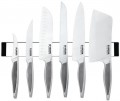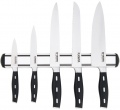Items in set
The number of items included in the kit. When calculating this amount, only items that can be directly used as a tool are taken into account: knives themselves, scissors, etc.; auxiliary equipment (for example, stands, musat) is not taken into account. For more information, see "Advanced".
Knives
—
Universal. These models have a fairly simple design: a medium-length blade with a rounded cutting edge and, most often, a smooth sharpening (although there are options with teeth). Knives of this type are present in almost every kitchen, because, in accordance with the name, they are suitable for a variety of tasks: cutting bread, peeling vegetables, butchering meat, etc. And although for some jobs such a knife may be less convenient than a specialized one, it is quite enough for most tasks that arise in simple everyday cooking. Yes, and professional chefs must have at least one universal model in their set.
—
Chief. Outwardly, such knives are similar to the universal ones described above, they have a smooth sharpening and, most often, a rounded cutting edge, but they are massive, have a wider blade, and some models are also noticeably longer.
Chef's knives can also be used for a variety of jobs, and the size and weight make it easier to cut large and "dense" foods.
—
Santoku. The name of these knives is of Japanese origin and means "three good things", which means the ability to cut, chop and crumble.
Santoku have a characteristic shape with a wide blade and a cutting edge located noticeably below the handle (straight or almost straight), due to which they somewhat resemble hatchets. Sharpening is smooth, with rare exceptions; i
...n classic santoku — much sharper than conventional knives. True to the name, this type is quite versatile, however, it is best suited for slicing — both in cubes and quite thin.
— Bunting. Deboning is the separation of meat from bone; accordingly, this is the main purpose of these knives, although the design allows them to be used for other purposes (in particular, butchering poultry). They have a long thin blade, which is quite wide at the handle, but narrows towards the point (quite sharply at once, then smoother). Sharpening is usually smooth.
— Fillet. Knives designed for cutting meat and fish into even, neat pieces, separating skin from meat and fillets from bones. The shape of the blade can be different: some models are more like boning, others are more like universal (both see above). However, all fillet knives have a long and flexible blade, which allows cutting even large pieces with a single movement of the knife (this ensures accuracy). Sharpening — only smooth.
— For cleaning. Knives designed for maximum convenience when peeling vegetables and fruits. Their main distinguishing feature is a short blade (significantly shorter than the handle). The cutting edge can be straight or concave, with the tip down; the first option is suitable for various fruits and vegetables, and the second is designed mainly for potatoes. In addition, a concave blade can be useful for decorating holiday tables. Knives of this type can be either smooth or serrated.
— Cutting. Many knives of this type practically do not differ externally from universal ones (see above); other models are equipped with a longer blade. The point in carving knives is often made almost in the centre of the blade. Their main purpose is to cut large vegetables and fruits (including watermelons and melons), as well as large pieces of meat and fish.
— For cutting. By design, such knives are very similar to boning knives, they also have a thin blade, widened at the handle and tapering towards the tip. However, they are intended primarily for cutting meat and fish into thin slices (including in Japanese cuisine).
— For bread. Knives designed for cutting bread are distinguished by a long blade with a uniform width (only at the very tip it tapers) and a cutting edge of a straight or slightly curved shape, most often with teeth; smooth sharpening is used extremely rarely. Thanks to the teeth, the knife easily overcomes the crust on the bread and cuts it without crushing. It can be useful for other products of a similar structure — for example, pineapples — and even, in extreme cases, as a replacement for a tomato knife (although the large length and mass of the blade may require some skill).
— For the steak. The name "for a steak" is also found. A rather peculiar kind of knives: formally they belong to the kitchen (and they have a characteristic design), but in fact they are intended for cutting the finished dish, i.e. are canteens. Steak knives often have an upwardly curved point and/or a serrated cutting edge (for ease of cutting through fried meat).
— For tomatoes. Knives designed for slicing fruits and vegetables that have a hard skin on the outside and a soft core on the inside. The length of the blade in such models is relatively small (smaller than in universal ones, but longer than in peeling knives), and the cutting edge may have teeth — they allow you to cut delicate products without crushing. However, there are knives for tomatoes with a classic smooth blade.
— For cheese. The classic cheese knife has a rather unusual appearance: rather large slots are often provided in the blade, the cutting edge is usually serrated, and the tip is bent upwards and made double. This allows you to comfortably cut even fairly soft varieties of cheese — the product does not stick to the knife; and with a “fork” point it is convenient to pick up individual pieces. However, there are other design options that are closer to classic knives — without slots in the blade and with a single edge.
— For pizza. This kind of knives is distinguished by a specific design: the blade has the form of a disk with a sharpened edge, which can rotate freely on the axis. During operation, such a disk literally rolls over the product being cut, and the cutting edge at the point of contact presses straight down, without moving back and forth. This allows you to easily cut pizza and other similar dishes for which classic knives are not very convenient.
— For butter. A distinctive feature of classic butter knives is a rather wide blade with a rounded end — in fact, there is no point as such in the design. It is convenient to take and spread butter with such knives. It should be noted that such tools are rather conditionally related to kitchen knives — like steak knives, they are more like cutlery, but they are often made in kitchen design. Noticeably less common is another kind of butter knives — tools with a working part in the form of a hook, one edge of which has teeth. They are used in situations where butter does not need to be spread, such as for dosing when cooking.
— Hatchet. He's a hack. As the name implies, this type of kitchen tool is closer to axes than knives: the main feature is a heavy, very wide blade designed for cutting. It is very convenient to cut large pieces of meat and poultry with a hatchet — it easily cuts not only veins, but also rather large bones.Handle material
The material from which the handles of the knives in the set are made. Usually, the same for the entire set.
—
Plastic. This material is easy to manufacture and inexpensive, it can easily be given any shape, colour and surface texture, and although its strength is inferior to steel, it is quite sufficient for most household tasks. In addition, plastic is chemically inert, easy to clean and resistant to water and kitchen chemicals. Thanks to all this, it is widely used in modern knives — in particular, the vast majority of entry-level and intermediate-level models have just such handles.
—
Wood. The wood is pleasing to the eye and touch, can withstand hits and falls without any problems, and its durable varieties are not necessarily expensive. At the same time, this material has a fibrous structure, due to which it is sensitive to water — it “absorbs” water, loses its presentation, resistance to cracks, chips and scratches (which is not very high anyway) and can even “bloom”, which for kitchen appliance is generally unacceptable. Also, these knives cannot be washed in dishwashers. As a result, wood is not widely used — either in the cheapest knives, where durability is not important, or vice versa, in premium-class models, where it plays the role of an stylish material. In the latter case, expensive wood species are used, which are usually also subjected to special processing.
...— Steel. This material is considered one of the most hygienic: it is easy to clean, and the design of the knife has virtually no gaps in which dirt can accumulate. In addition, steel handles look very solid, durable and hard, withstandhits and falls without any problems, and are also scratch resistant. On the other hand, a steel handle is more likely to slip out of your hand than a wooden or plastic one.
— Steel with an insert. A variant designed to eliminate the main disadvantage of all-steel handles (see above) — an increased likelihood of slipping. This is what inserts are used for: they are made of rubber, plastic or other similar material that increases the "grip" of the palm with the knife handle. The presence of inserts is the only difference between handles of this type and all-steel; the rest of the features are completely similar.Country of origin
The country of origin of the brand under which the knife set is marketed. Usually, it is indicated by the "homeland" of the manufacturing company or by the location of its headquarters.
There are many stereotypes associated with the “nationality” of brands and products, but most of them have no basis nowadays. First, the actual place of production is often different from the brand's country of origin. Secondly, the quality of the goods depends not so much on geography, but on the policy of a particular company and how carefully this very quality is controlled in it. Therefore, you should pay attention to the country of origin of the brand only if you fundamentally want or (do not want) to support a manufacturer from a certain state. Quality is best judged by the reputation of a particular brand and the general price category.

